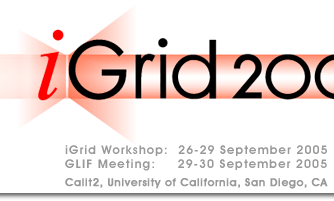News Releases
The Time Is Now: Bust Up the Box!
By John Markoff
New York Times
San Diego, CA, October 5, 2005 - Computing is breaking out of the beige box. Millions of miles of fiber-optic cables are weaving together software that lives on the Internet and data moving at the speed of light into a single global fabric.
It has been almost two decades since Sun Microsystems pioneered the slogan “the network is the computer.” Today, after many false starts, that idea is a reality.
Along with relentless technical advances, one force behind this change has been the billions of dollars spent by telecom companies on fiber-optic lines before the end of the tech boom. That splurge was a factor in driving many of those companies into bankruptcy, but also helped reduce the cost of transmitting data.
For decades increases in the speeds of computer networks trailed the exponentially accelerating speed of microprocessor chips. Now the balance between the power of computer processing and networking has fundamentally reversed, and the rapid rise of transmission speeds is beginning to have a revolutionary impact on how computers are used and what they can do.
“That box of things that used to be contained inside of your PC now gets spread out literally on a global basis,” said Mike Volpi, a senior vice president at Cisco Systems, the largest networking company in the world. The changes are taking place both at the highest end of the supercomputing world and just as swiftly in the consumer World Wide Web.
Where software applications like Microsoft Word or Autodesk’s AutoCAD were once standalone monoliths that functioned in just a single machine, the new distributed applications are now remarkably adaptable. They are frequently spread across large and small computer systems in order to harness more processing power, and programs now dart about through the networks, relocating themselves to save power or to use resources more efficiently.
Google is perhaps the most extreme example of the future of networked computing. Today the company is a major buyer of fiber-optic network capacity to interconnect a computing system that is spread over more than 100,000 processors in over a dozen data centers around the world.
Moreover, for everyday Web surfers, an exploding array of services is being built by using the software equivalent of Lego blocks, as companies like Google, Yahoo and Microsoft begin to make software components available to “mash-up,” that is, to link programs running on different servers in different places, in new distributed applications on multiple computers and frequently available free.
Earlier this year a classic mash-up was created by Paul Rademacher, a Silicon Valley programmer who connected apartment rentals on the Craigslist Web site with Google Maps, in the process creating a new Web service, a program that resides simultaneously in many places on the Internet.
That model has initiated a growing array of applications involving so-called distributed computing for corporations, consumers and scientists. “Today we are Google-mashing everything,” said Bill St. Arnaud, senior director of advanced networks for Canarie, a government-sponsored high-speed network based in Ottawa that links research laboratories.
It is now possible to connect computers on opposite sides of the world by an optical fiber capable of carrying 10 billion bits of information a second…
To read the entire article, see: www.nytimes.com/2005/10/05/technology/techspecial/05markoff.html


